Fraunhofer diffraction
In optics, the Fraunhofer diffraction equation is used to model the diffraction of waves when the diffraction pattern is viewed at a long distance from the diffracting object, and also when it is viewed at the focal plane of an imaging lens.[1][2] In contrast, the diffraction pattern created near the object, in the near field region, is given by the Fresnel diffraction equation.
The equation was named in honor of Joseph von Fraunhofer although he was not actually involved in the development of the theory.[3]
This article explains where the Fraunhofer equation can be applied, and shows the form of the Fraunhofer diffraction pattern for various apertures. A detailed mathematical treatment of Fraunhofer diffraction is given Fraunhofer diffraction (mathematics).
The Fraunhofer diffraction equation
When a beam of light is partly blocked by an obstacle, some of the light is scattered around the object, and light and dark bands are often seen at the edge of the shadow – this effect is known as diffraction.[4] These effects can be modelled using the Huygens–Fresnel principle. Huygens postulated that every point on a primary wavefront acts as a source of spherical secondary wavelets and the sum of these secondary waves determines the form of the wave at any subsequent time. Fresnel developed an equation using the Huygens wavelets together with the principle of superposition of waves, which models these diffraction effects quite well.
It is not a straightforward matter to calculate the displacement given by the sum of the secondary wavelets, each of which has its own amplitude and phase, since this involves addition of many waves of varying phase and amplitude. When two waves are added together, the total displacement depends on both the amplitude and the phase of the individual waves: two waves of equal amplitude which are in phase give a displacement whose amplitude is double the individual wave amplitudes, while two waves which are in opposite phases give a zero displacement. Generally, a two-dimensional integral over complex variables has to be solved and in many cases, an analytic solution is not available.[5]
The Fraunhofer diffraction equation is a simplified version of the Kirchhoff's diffraction formula and it can be used to model the light diffracted when both the light source and the viewing plane are effectively at infinity with respect to the diffracting aperture.[6] In this case, the incident light is a plane wave so that the phase of the light at each point in the aperture is the same. The phase of the contributions of the individual wavelets in the aperture varies linearly with position in the aperture, making the calculation of the sum of the contributions relatively straightforward in many cases.
Strictly speaking, the Fraunhofer approximation only applies when the diffracted pattern is viewed at infinity, but in practice it can be applied in the far field, and also in the focal plane of a positive lens.
Far field
| Fraunhofer diffraction occurs when:
|
 – aperture or slit size, – aperture or slit size,
|
When the distance between the aperture and the plane in which the pattern is observed is large enough that the difference in phase between the light from the extremes of the aperture is much less than the wavelength, then individual contributions can be treated as though they are parallel. This is often known as the far field and is defined as being located at a distance which is significantly greater than W2/λ, where λ is the wavelength and W is the largest dimension in the aperture. The Fraunhofer equation can be used to model the diffraction in this case.[7]
For example, if a 0.5mm diameter circular hole is illuminated by a laser with 0.6μm wavelength, the Fraunhofer diffraction equation can be employed if the viewing distance is greater than 1000mm.
Focal plane of a positive lens
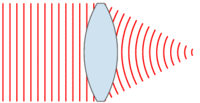
A plane wave incident on a positive lens is focused at a point by the lens; all the 'rays' have the same phase at the point of focus, so that this is equivalent to viewing the plane wave at infinity. Thus, if the diffracted light is focused with a lens, the observed diffraction pattern can be modelled using Fraunhofer diffraction.[8] The diffracted light can be considered to be made up of a set of plane waves of varying orientation. When a lens is located in front of the diffracting aperture, each plane wave is brought to a focus at a different point in the focal plane with the point of focus being proportional to the x- and y-direction cosines, so that the variation in intensity as a function of direction is mapped into a positional variation in intensity.2 converging lenses are one for making rays to move parallel other for focusing a ray at point p
Examples of Fraunhofer diffraction
In each of these examples, the aperture is illuminated by a monochromatic plane wave at normal incidence.
Diffraction by a slit of infinite depth
.svg.png)
The width of the slit is W. The Fraunhofer diffraction pattern is shown in the image together with a plot of the intensity vs. angle θ.[9] The pattern has maximum intensity at θ = 0, and a series of peaks of decreasing intensity. Most of the diffracted light falls between the first minima. The angle, α, subtended by these two minima is given by:[10]
Thus, the smaller the aperture, the larger the angle, α subtended by the diffraction bands. The size of the central band at a distance z is given by
For example, when a slit of width 0.5 mm is illuminated by light of wavelength 0.6 µm, and viewed at a distance of 1000 mm, the width of the central band in the diffraction pattern is 2.4 mm.
The fringes extend to infinity in the y direction since the slit and illumination also extend to infinity.
If W < λ, the intensity of the diffracted light does not fall to zero, and if D << λ, the diffracted wave is cylindrical.
Semi-quantitative analysis of single slit diffraction
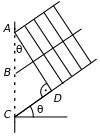
We can find the angle at which a first minimum is obtained in the diffracted light by the following reasoning. Consider the light diffracted at an angle θ where the distance CD is equal to the wavelength of the illuminating light. The component of the wavelet emitted from the point A which is travelling in the θ direction is in anti-phase with the wave from the point B at middle of the slit, so that the net contribution at the angle θ from these two waves is zero. The same applies to the points just below A and B, and so on. Therefore, the amplitude of the total wave travelling in the direction θ is zero. We have:
The angle subtended by the first minima on either side of the centre is then, as above:
There is no such simple argument to enable us to find the maxima of the diffraction pattern.
Diffraction by a rectangular aperture
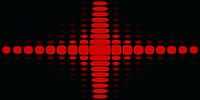
The form of the diffraction pattern given by a rectangular aperture is shown in the figure on the right.[11] There is a central semi-rectangular peak, with a series of horizontal and vertical fringes. The dimensions of the central band are related to the dimensions of the slit by the same relationship as for a single slit so that the larger dimension in the diffracted image corresponds to the smaller dimension in the slit. The spacing of the fringes is also inversely proportional to the slit dimension.
If the illuminating beam does not illuminate the whole length of the slit, the spacing of the vertical fringes is determined by the dimensions of the illuminating beam. Close examination of the double-slit diffraction pattern below shows that there are very fine horizontal diffraction fringes above and below the main spot, as well as the more obvious horizontal fringes.
Diffraction by a circular aperture
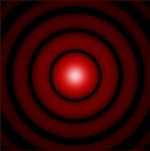
The diffraction pattern given by a circular aperture is shown in the figure on the right.[12] This is known as the Airy diffraction pattern. It can be seen that most of the light is in the central disk. The angle subtended by this disk, known as the Airy disk, is
where W is the diameter of the aperture.
The Airy disk can be an important parameter in limiting the ability of an imaging system to resolve closely located objects.
Diffraction by an aperture with a Gaussian profile
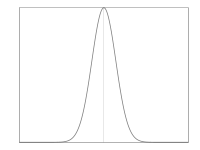
The diffraction pattern obtained given by an aperture with a Gaussian profile, for example, a photographic slide whose transmissivity has a Gaussian variation is also a Gaussian function. The form of the function is plotted on the right, and it can be seen that, unlike the diffraction patterns produced by rectangular or circular apertures, it has no secondary rings.[13] This technique can be used in a process called apodization—the aperture is covered by a Gaussian filter, giving a diffraction pattern with no secondary rings.
The output profile of single mode laser beam may have a Gaussian intensity profile and the diffraction equation can be used to show that it maintains that profile however far away it propagates from the source.[14]
Diffraction by a double slit
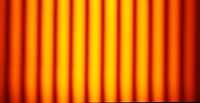
In the double-slit experiment, the two slits are illuminated by a single light beam. If the width of the slits is small enough (less than the wavelength of the light), the slits diffract the light into cylindrical waves. These two cylindrical wavefronts are superimposed, and the amplitude, and therefore the intensity, at any point in the combined wavefronts depends on both the magnitude and the phase of the two wavefronts.[15] These fringes are often known as Young's fringes.
The angular spacing of the fringes is given by
The spacing of the fringes at a distance z from the slits is given by [16]
where d is the separation of the slits.
The fringes in the picture were obtained using the yellow light from a sodium light (wavelength = 589 nm), with slits separated by 0.25 mm, and projected directly onto the image plane of a digital camera.
Double slit interference fringes can be observed by cutting two slits in a piece of card, illuminating with a laser pointer, and observing the diffracted light at a distance of 1 m. If the slit separation is 0.5 mm, and the wavelength of the laser is 600 nm the spacing of the fringes viewed at a distance of 1 m would be 1.2 mm.
Semi quantitative explanation of double-slit fringes
The difference in phase between the two waves is determined by the difference in the distance travelled by the two waves.
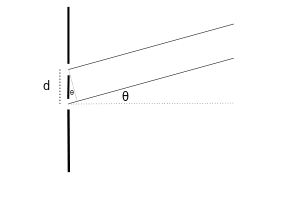
If the viewing distance is large compared with the separation of the slits (the far field), the phase difference can be found using the geometry shown in the figure below right. The path difference between two waves travelling at an angle θ is given by:
When the two waves are in phase, i.e. the path difference is equal to an integral number of wavelengths, the summed amplitude, and therefore the summed intensity is maximum, and when they are in anti-phase, i.e. the path difference is equal to half a wavelength, one and a half wavelengths, etc., then the two waves cancel and the summed intensity is zero. This effect is known as interference.
The interference fringe maxima occur at angles
where λ is the wavelength of the light. The angular spacing of the fringes is θf is given by
When the distance between the slits and the viewing plane is z, the spacing of the fringes is equal to zθ and is the same as above:
Diffraction by a grating
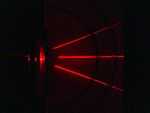
A grating is defined in Born and Wolf as "any arrangement which imposes on an incident wave a periodic variation of amplitude or phase, or both".
A grating whose elements are separated by S diffracts a normally incident beam of light into a set of beams, at angles θn given by:[17]
This is known as the grating equation The finer the grating spacing, the greater the angular separation of the diffracted beams.
If the light is incident at an angle θ0, the grating equation is:
The detailed structure of the repeating pattern determines the form of the individual diffracted beams, as well as their relative intensity while the grating spacing always determines the angles of the diffracted beams.
The image on the right shows a laser beam diffracted by a grating into n = 0, and ±1 beams. The angles of the first order beams is about 20°; if we assume the wavelength of the laser beam is 600 nm, we can infer that the grating spacing is about 1.8 μm.
Semi-quantitative explanation
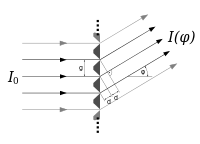
A simple grating consists of a series of slits in a screen. If the light travelling at an angle θ from each slit has a path difference of one wavelength with respect to the adjacent slit, all these waves will add together, so that the maximum intensity of the diffracted light is obtained when:
This is the same relationship that given above.
See also
- Fraunhofer diffraction (mathematics)
- Diffraction
- Huygens–Fresnel principle
- Kirchhoff's diffraction formula
- Fresnel diffraction
- Airy disc
- Fourier optics
References
- ↑ Born & Wolf, 1999, p. 427.
- ↑ Jenkins & White, 1957, p288
- ↑ http://scienceworld.wolfram.com/biography/Fraunhofer.html
- ↑ Heavens and Ditchburn, 1996, p. 62
- ↑ Born & Wolf, 1999, p. 425
- ↑ Jenkins & White, 1957, Section 15.1, p. 288
- ↑ Lipson, Lipson and Lipson, 2011, p. 203
- ↑ Hecht, 2002, p. 448
- ↑ Hecht, 2002, Figures 10.6(b) and 10.7(e)
- ↑ Jenkins & White, 1957, p. 297
- ↑ Born & Wolf, 1999, Figure 8.10
- ↑ Born & Wolf, 1999, Figure 8.12
- ↑ Hecht, 2002, Figure 11.33
- ↑ Hecht, 2002, Figure 13.14
- ↑ Born & Wolf, 1999, Figure 7.4
- ↑ Hecht, 2002, eq. (9.30)
- ↑ Longhurst, 1957, eq.(12.1)
Reference sources
- Born M & Wolf E, Principles of Optics, 1999, 7th Edition, Cambridge University Press, ISBN 978-0-521-64222-4
- Heavens OS and Ditchburn W, Insight into Optics, 1991, Longman and Sons, Chichester ISBN 978-0-471-92769-3
- Hecht Eugene, Optics, 2002, Addison Wesley, ISBN 0-321-18878-0
- Jenkins FA & White HE, Fundamentals of Optics, 1957, 3rd Edition, McGraw Hill, New York
- Lipson A., Lipson SG, Lipson H, Optical Physics, 4th ed., 2011, Cambridge University Press, ISBN 978-0-521-49345-1
- Longhurst RS, Geometrical and Physical Optics,1967, 2nd Edition, Longmans, London

 – wavelength,
– wavelength,
 – distance from the aperture
– distance from the aperture












